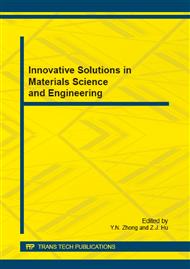p.17
p.21
p.27
p.31
p.35
p.41
p.46
p.51
p.57
The Use of Quasi-Static Indentation Testing to Evaluate Low-Velocity Impact Resistance of Ex Situ Toughened Composite
Abstract:
The aim of this study was to investigate the valuable impact damage parameters from quasi-static indentation testing to access the low-velocity impact behaviour of ex-situ toughened composites by comparing low-velocity impact and quasi-static test results (the same boundary conditions). In terms of the delamination damage threshold load and indentation depth, quasi-static tests predicted the impact damage resistance well. However, only very conservative estimates of maximum load due to the final fibre failure under higher energy level were achieved. This phenomenon is attributed to two factors. First, energy during quasi-static indentation event is completely transformed or absorbed by the laminate, where it is stored elastically in panel bending or absorbed by the creation of damage, without the energy in the form of vibration, heat, inelastic behaviour of the impactor or the supports. Second, strain rate effect may have a remarkable influence on the fibre failure but on undamaged and delaminated damage.
Info:
Periodical:
Pages:
35-40
Citation:
Online since:
November 2014
Authors:
Price:
Сopyright:
© 2015 Trans Tech Publications Ltd. All Rights Reserved
Share:
Citation:


